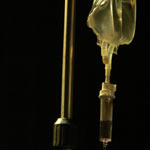Nearly 79,000 residents (5.68 percent) have feeding tubes in the long term care setting, according to March 2012 data from the Online Survey, Certification, and Reporting (OSCAR) data. In fact, a majority of elderly patients undergoing feeding tube placements are discharged to nursing homes after the procedure.

For many residents, these tubes become a long-term condition, requiring continued diligence by the nursing home staff for assessment, maintenance, and documentation beyond the time frame of the skilled stay.
Feeding tube placement provides an open tract to internal organs, and preventing deterioration of this chronic surgical site is crucial to the health and well-being of the individual.
Optimum Conditions
A normal tube site should have a moist, red stoma with intact surrounding skin. However, with time and the persistent presence of the feeding tube, issues may arise that lead to complications such as leakage; infection and/or cellulitis; hypergranulation; bleeding; or peritubular skin that is denuded, excoriated, erythematous, macerated, ulcerated, or dry and crusty.
These issues may be brought on by trauma or aggravation. For example, a confused resident may pull on the tube or clothing could repeatedly catch on the tube. In addition, the tube could be positioned incorrectly or the resident could have gained or lost weight, which can impact the fit of the tube. Leakage can become very problematic to a person due to the discomfort caused by the combination of fluids irritating the skin, such as gastric, feeding formula, medications, and water from flushes.
Dignity issues are also important. The embarrassment of soiled or odorous clothing inhibits residents from participating in social activities and even the pleasure of wearing favorite clothing.
Leakage may occur due to local fungal or bacterial skin infections, caustic agents used to cleanse the surrounding skin or tube, tube failure, and stoma dilation with time.
Suggested treatment for leakage includes correcting comorbidities, such as blood sugar or malnutrition, and local measures that address skin breakdown.
Tube stabilization is also important to decrease leakage. However, it is a misconception that placement of a larger-size tube through the same feeding tube tract will resolve the leakage problem.
Watch The Dressings
Traditionally, feeding tube sites have been covered with gauze. Fluids drawn into the gauze dressing evaporate, leaving dried particulate matter such as blood and protein behind, forming an impermeable layer.
In the course of a dressing change, the dried proteins or scab pull at the surrounding tissue, creating inflammation and irritation that may result in drainage from the surrounding tissues or further tissue damage.
Gauze also traps gastric leakage against the skin, resulting in local irritation, while foam dressings can lift the drainage away from the skin, and calcium alginates are known to trap or sequester drainage away from the skin.
With the incidence of dementia and incontinence in today’s nursing home population, it is not uncommon to come across a confused resident who, being uncomfortable after an incontinent episode, reaches down for hygienic purposes and then tugs on the feeding tube area, using the hand contaminated with feces.
With a gauze-and-tape-only dressing (or a tube left open to air) there is no bacterial barrier to prevent the entry of this contamination into the body via the stoma. Thus, the use of gauze dressings may lead to resident discomfort, prolonged healing of the incision site, or peritubular skin loss and an increased risk of infection.
To help maintain each person’s dignity and quality of life with the least amount of pain possible, while adhering to federal regulations regarding quality of care, skilled evaluations are indicated for the peritubular skin defects or wounds in residents with feeding tube complications.
Also, local measures to address the skin breakdown are necessary, including nursing assessment of the feeding tube site and peritubular area.
Peritubular Skin Assessment
Maintenance of healthy peritubular skin is paramount for resident comfort and to prevent tissue erosion, which may lead to more significant feeding tube site complications. Likewise, the peritubular skin assessment provides information that may provide the first indication of complications.
A daily skin assessment should include inspection of the site for any signs and symptoms of infection, which could include erythema, induration, or pain. Additionally, presence of gastric drainage or leakage around the tube should be noted. A small amount of clear liquid drainage is normal; however, any increased amounts that saturate dressings or soil clothing indicate possible complications.
Drainage that is odorous, green or yellow in color, or purulent should be included in the assessment as well. Observing for excess tissue (hypergranulation) growing around the tube is another component of the assessment. Hypergranulation may be a result of the body’s response to the foreign object (tube appliance) and may be uncomfortable to the resident, as it is commonly friable, bleeds easily, or has excess exudate.
The peritubular area should be assessed to determine if skin tissue is intact or exhibits signs of maceration, excoriation, denudement, erythema, ulceration, or buildup or layering of dry/crusty drainage.
Document Assessment Data
The information gathered from this assessment is an essential component of feeding tube management and should be documented in the resident’s medical record.
The documentation communicates information that may indicate the need for interventions and collaboration with health care providers addressing the possible complications.
Additionally, documentation regarding the resident’s overall condition such as dementia, agitation, confusion, incontinence, and pulling at the tube site or tube stabilization/positioning difficulties may further indicate a need for advanced wound products, with more frequent dressing changes such as daily, for an unspecified amount of time in order to appropriately manage the resident’s care.
Rebekah Grigsby, MSN, RN, CWCN, CCCN, is education liaison and clinical specialist, American Medical Technologies, Irvine, Calif. Holly Korzendorfer, PT, PhD, CWS, FACCWS, is vice president of clinical development, Dermarite, Paterson, N.J.